This post contains some of the best free nesting software for 2D cutting optimization. This software takes a file that contains shapes and will generate a sheet with an optimized sheet layout for their cutting. They utilize some of the best algorithms out there to generate the nesting.
In the sheet metal industry, nesting refers to the process of finding out the best way to utilize a metal sheet for cutting shapes from it. You need to cut the maximum shapes from it with minimum scrap left. The aim basically here is to minimize the waste and to optimize the overall production. There is a good deal of prominent software out there which do this, but here I will only talk about the free ones that produce as good an output as those paid ones.
The tools or software mentioned in this post here take an input file to get the shapes that you want to cut. It can be an SVG file or a DXF file that you can design in any CAD software. Or, you can just give measurements for the regular shapes such as radius for circle, double radius for rings, etc. The algorithms that these software use keep finding the best fit to generate the sheet layout. After that, you can just export the design you think is best.
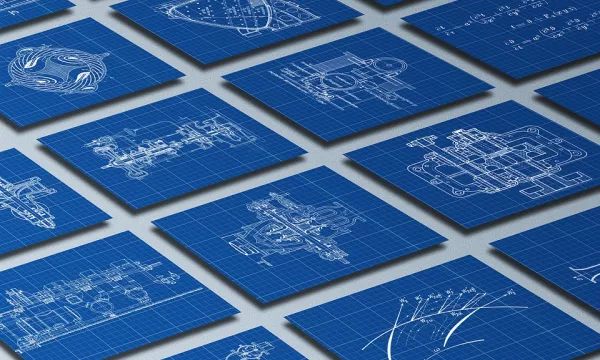
3 Best Free Nesting Software for 2D Cutting Optimization
Deepnest
Deepnest is one of the best free nesting software that you can use on Windows. It helps you generate the cutting pattern on a sheet after taking all the shapes that you want to cut from an SVG file. It will continue to search for better solutions until you tell it to stop. After it is done, it will generate multiple patterns to choose from. You can select the one that is on the top and is by default highly optimized.
This is open-source software, as well as cross-platform. You can easily use it on macOS, Linux, and Windows. There are no restrictions in it on anything. You just give it an input file and then wait for it to generate the final optimized cutting pattern. The nesting output that it generates can be exported back in the SVG format. Other than that, you can also export a file in DXF format as well.
Using this software is very simple. You just download it from the link above. Run it directly after that, and you will find its interface like this.
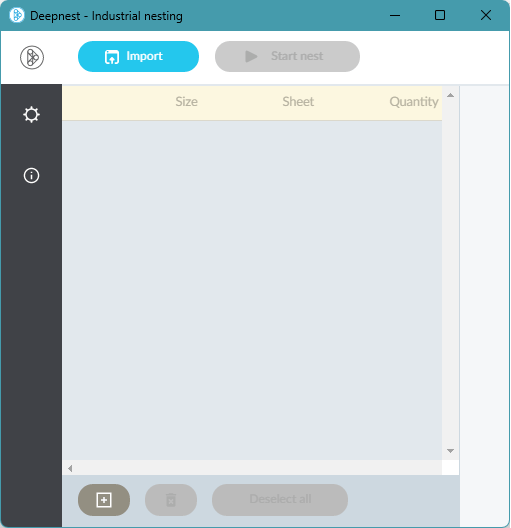
Now, you import a pattern in it that you want to cut. For that, you have to locate an SVG file and feed that to it. It will load the file and you have to select the largest sheet that will be used to cutout shapes. Finally, you start the process.
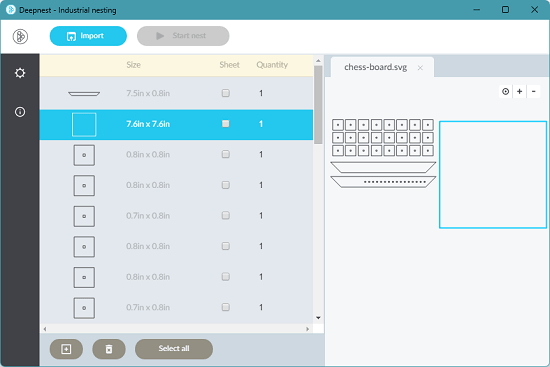
It will now continue to find multiple possible solutions. All the solutions for cutting that it generates can be seen on the interface. The one on the top is the most optimized one. But you can peek into other solutions as well. After you find the most suitable one, you just stop the process.
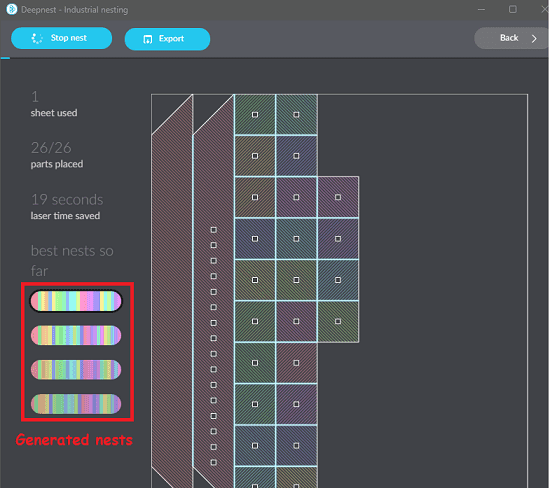
In this way, you can make use of this simple and powerful nesting software on Windows. In the same way, you can use it on other platforms as well. Once it generates the solution for your cutting, you can export the output in DXF format or as SVG file.
SVGnest
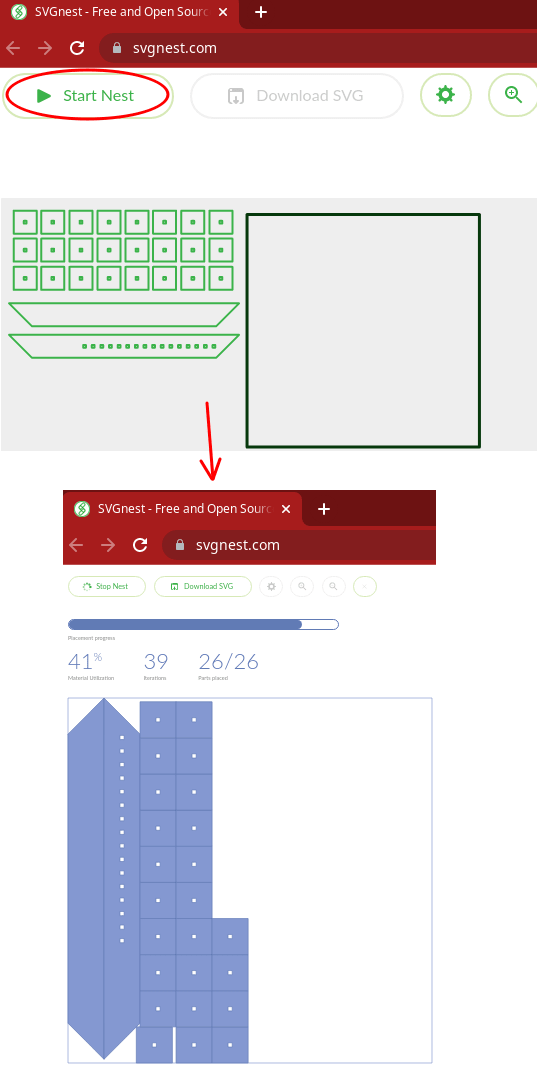
SVGnest is a free and open source 2D cutting optimization software that you can use. It runs in the browser and you can either run from its source on your PC and there is a hosted version of this tool as well. As the name suggests. It takes an SVG file from you which contains all the shapes that you want to cut.
In the source SVG file, you have to specify the sheet as well on which you want to do the cutting. After analyzing the input SVG file, it generates the final cutting layout which is both optimal and suitable for your job.
This tool is written in HTML and you just need to follow the instructions on its GitHub repository to use it. Just like other tools above, it generates multiple variations of the final sheet layout. The final file is generated in SVG format too and you can easily export that.
So, to quickly give it a try, you can use the hosted version of this nesting software from the link above. After that, you simply start by uploading an SVG file that contains all the shapes. Let it process it and then it will generate the results which you can export.
Rings2D
Rings2D is basically a command line nesting software that you can use. It is cross-platform as well, since you can run it on any Linux based OS. This is quite a different nesting software that you can use, as it mostly focuses on cutting layout for rings or circles from a metal sheet. It uses a configuration file along with a CSV file to take measurements.
It takes a sheet layout as well, which can be rectangular or circular. Here are the two ways in which this tool works:
- Give it a set of ring/disk parts and circular sheet in configuration. It will then find the smallest possible sheet radius to pack all those parts.
- Give it a set of ring/disk parts and rectangular sheet in configuration. It will find the smallest width of the rectangular sheet.
You can download it from the above link to start using it on Windows. There is no dependency required as it comes with its self-contained binary. You just extract the ZIP file.
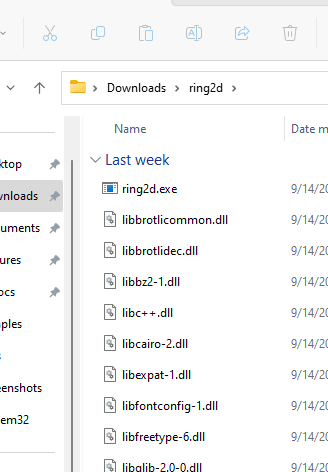
Prepare the configuration file in TOML format. There are sample configuration files in the ZIP that you can analyze to get an idea of how it works.
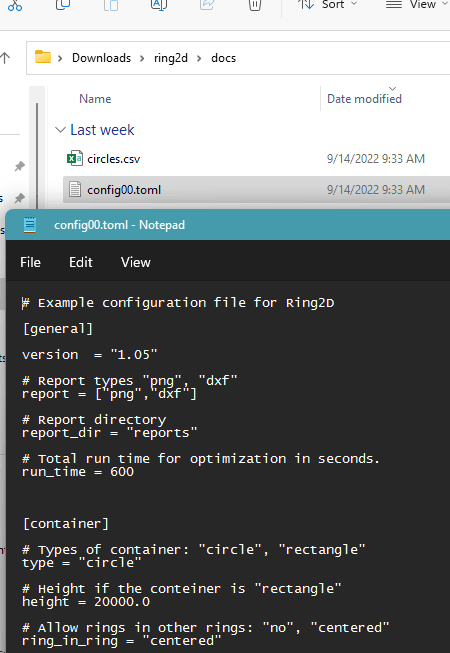
Now, you need to prepare a CSV file with the measurements for rings and disks that you want to cut. Don’t name any column, just specify comma separated values for radius, outer radius in order and save the changes. Enter the measurement for every disk/ring in each line.

Run this tool like this and then wait for a few seconds. It will generate a PNG image and a DXF file in the reports folder with an optimized layout. You can see this in the screenshot below.
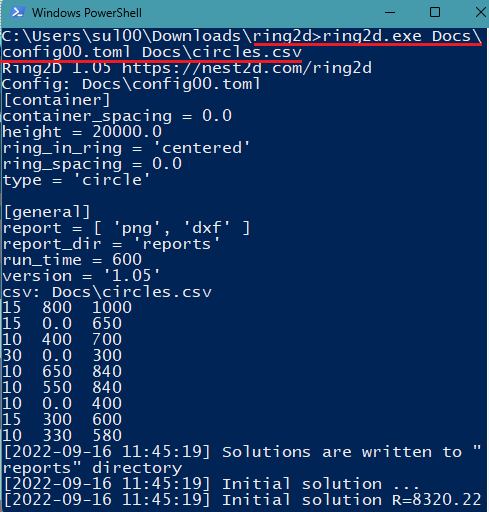
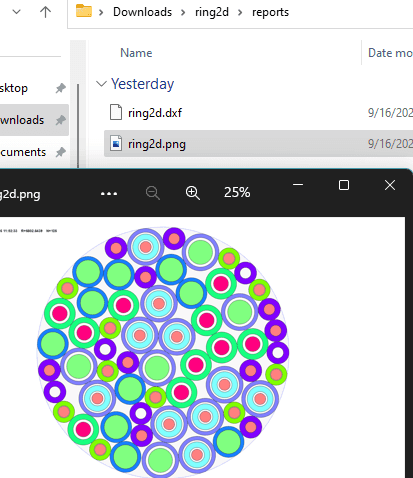
This way, you can now make use of this simple command line nesting software to generate 2D cutting optimization settings for circular as well rectangular sheets. The process is simple and very straightforward. You will get the hang of this software after using it a few times.
Final thoughts:
These are the best free nesting software that I could find which you can use on Windows. If you belong to the sheet metal industry then you will definitely find them useful. Just give them the shapes you want to cut from a metal sheet and they will generate the best layout which is optimal for your design as well as result in less scrap.